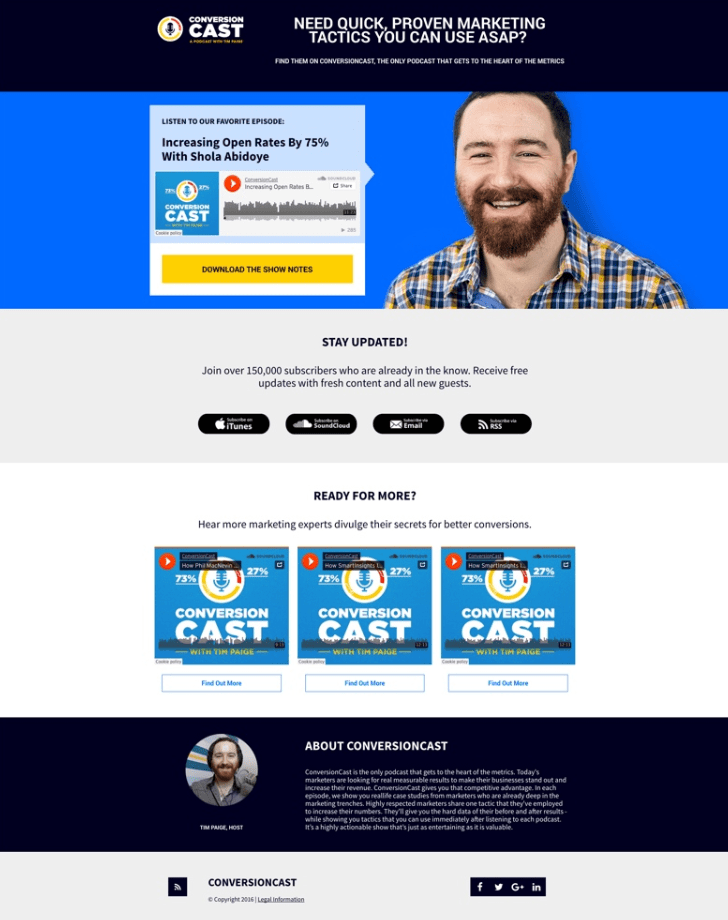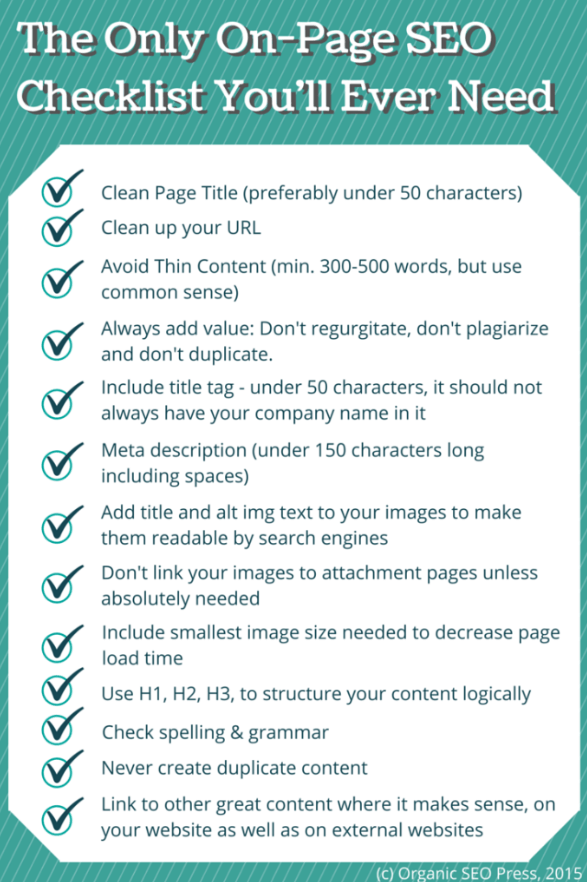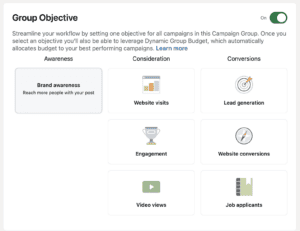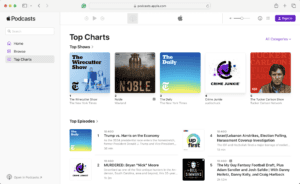Marketing your podcast is just as important as creating it. Even the best content can go unnoticed without a solid plan to reach your audience.
In this podcast marketing guide, you’ll learn everything you need to know to grow your listener base and build a loyal community around your podcast. Let’s turn your passion project into a must-hear sensation!
(Want to learn how to promote an episode after you publish it? Check out our guide on promoting individual episodes.)
The Two Pillars of Podcasting
Before jumping right into our top promotional strategies, let’s take one step back to assess the foundation of podcasting: quality content and time. We need to make sure what we create is worth promoting and that we have realistic expectations around the timelines of success.
Quality content
Marketing a bad product is a waste of time. No amount of money, creative marketing angles, or Hail Mary strategies will grow a stale podcast.
What makes a good product? It has to hit these three qualities:
- Valuable: Your listeners need to gain something from the episode. They either learned new information or a skill, were entertained, or satisfied a curiosity.
- Unique: Your podcast’s point of view adds something new to the conversation, however slight. Uniqueness varies for every topic, so compare yourself others in your niche.
- Sticky: You podcast needs to capture and sustain an audience’s attention. If your current listeners aren’t consistently consuming your episodes in full, focus your efforts on the content. Listen to podcasts that are similar to yours, study their formats, content, and structure. Think about how you can incorporate those features into your show and improve upon what they’ve created.
The best long-term podcast marketing strategy is by providing value. Gimmicks and shortcuts may work in the short-term, but they won’t sustain you. Instead of leaping on the latest marketing trend, focus on creating value through strong relationships and quality content.
Time
We know Rome wasn’t built in a day and the same can be said for podcast audiences.
Remember, many hosts produce a podcast for 5-6 months before seeing major upticks in their listenership. That means persistently promoting ten top notch episodes that ultimately see minimal engagement. Don’t get discouraged. Podcast marketing is a long term endeavor.
Trust that growing a podcast takes time and growth depends on consistently producing engaging content.
Finding the Right Podcast Marketing Strategies
We’ll get into practical podcast marketing strategies in a moment, but every show is different. How you promote your show depends on your content and your audience. This means a big part of marketing is finding the strategies that work for your show.
How do you do that? By considering your audience and then experimenting with new ideas.
Focus on Your Audience
It would be great if your podcast appealed to everyone, but that’s probably not the case. Instead of trying to market to all podcast listeners, focus on the ones who get the most value from your show.
Over time, take steps to learn as much as you can about that audience so you can design promotions that finds them with the right messaging. Build an audience persona document like the one below. Consult it regularly during your podcast marketing.
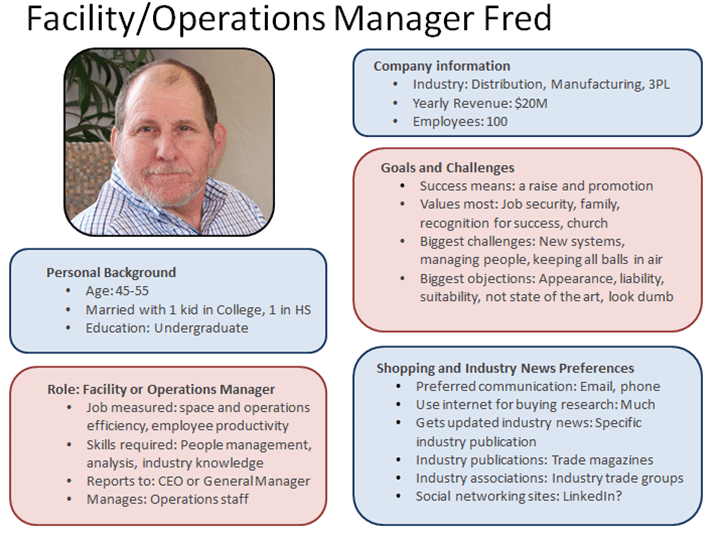
Experiment and Measure
It’s important to try new things and measure the results. In fact, you should run multiple tests to find the tactics that work.
For instance, let’s say you decide to answer questions on Quora to drive traffic to your podcast’s website. It would be smart to add tracking codes to the links in your answer to determine how many people ultimately land back on your site. Without any tracking parameters, it’s difficult to decide if a podcast marketing tactic is successful or not.
The data generated by tracking experiments provides actionable insights into what channels drive new subscribers. In marketing, focusing on the real world numbers is a better strategy than going with your gut feeling.
Podcast Marketing Steps
1. Build a Podcast Website
A podcast website is your show’s “home base,” a platform that you control completely. Listeners can explore new episodes, find show notes and transcriptions, and learn more about your brand. A podcast website also makes your show discoverable on the web when potential listeners search for terms related to your show.
Your website should have a blog-style section so episodes can be posted on unique pages. You should also have lots of links to your podcast on the major social media listening apps.
Furthermore, your podcast website should have some way for visitors to opt into your email list. This will allow you to notify them whenever new content is available. Email subscribers are often a podcast’s most engaged listeners.
With Seriously Simple Podcasting, you can manage your podcast and create episode pages right inside your WordPress dashboard. Visitors can listen to your show right on your website.
Tip
Castos creates customizable podcast webpages for you automatically. Every episode is available in one place and you can update the look and feel to match your show’s branding.
2. Set Up Your Social Media Channels
Facebook, Twitter, and TikTok are essential to expose your show to the world, but there may be other platforms that are relevant to your audience. For interest, a podcast about organization and managing the home would probably want a presence on Pinterest.
Most importantly, focus on the platform where your audience hangs out the most, even if it’s a non-mainstream place.
3. Build an Email Newsletter Template
Email marketing has the best return on investment out of all the digital marketing channels: 4400% ROI and $44 for every $1 spent. It’s a simple and intimate way to connect with your fans.
Collect the email addresses of your listeners on your website so you can send an email every time you publish a new episode. OptinMonster, HelloBar, and Thrive Leads are great apps to collect addresses on your site. Use an email marketing platform to send updates, such as Drip, Convertkit, Mailchimp, or MailerLite.
Inside your email platform, design a simple and accessible template to use each time you publish new content. Here’s a great example from A24. It’s a single column with logo, episode title, featured image, a brief comment about the episode, and links to listen.
4. Prepare at Least Three Episodes
You may want to publish that first episode, but that’s rarely a good idea. When you listeners explore your show, they may want to check out several episodes. Don’t disappoint them by not having enough available.
Online business coach Pat Flynn recommends posting three to five episodes at launch so new listeners can binge a bit. “I actually received negative reviews from people who had listened to the first episode and were upset that there was only one,” he says.
We recommend publishing your first three at once. Five is also okay, but no more than that. You don’t want to overwhelm them with an enormous amount of episodes up front. If you were to publish 10 episodes at once, for example, five of them would never be played.
In each episode, make sure to ask your audience to rate and review your podcast on whichever listening app they prefer. Getting ratings quickly is a key way to convince those listening platforms to push your show higher in their category listings.
After your first three episodes, settle into whatever publishing interval you like, such as once a week, twice a month, etc.
5. Submit Your RSS Feed to Podcast Directories/Listening Apps
A big part of building an audience is making your content available where they prefer to listen. Once you have your podcast RSS feed configured, submit your show to all of the major podcast directories, including YouTube. Each platform takes a few days to approve your show, so it’s important to do this well ahead of your official launch day.
Check out these guides to submitting your show to the major listening apps:
- How to Submit Your Podcast to Apple Podcasts
- How to Start a Podcast on Spotify with Upload Steps
- How to Upload a Podcast to YouTube
Then go through this guide to submit your show to all of the smaller apps: 28 Podcast Directories to Upload & Post Your Podcast Shows.
6. Ask for Ratings and Reviews
If you want your podcast to be successful, you need lots of high ratings and positive reviews. Potential listeners are more inclined to try your show if it has lots of glowing recommendations, especially if you get into the New & Noteworthy section on Apple Podcasts. The sooner you get ratings and reviews, the faster your listenership will grow.
How do you get ratings and reviews? Ask for them! Each episode should include a verbal call-to-action that asks your listeners to rate and review the show right now.
Additionally, it’s smart to include a call-to-action in each email you send to your audience. Link them to the page on Apple Podcasts, Google Podcasts, and Spotify where they can leave their review. Say something like this:
Help our show grow! Please leave a five-star review on your favorite listening app.
7. Attend In-Person Events
Word-of-mouth advertising is one of the most effective podcast marketing strategies available. Finding the right places to spread your message is step one. Your audience congregates in certain places in the real world so it’s your job to find them and attend as well.
Research conferences, meetups, or local events in your area that relate to your podcast. Then when you go, have a plan ahead of time to make the most of the event.
Network your heart out by talking to the event’s attendees and speakers. Don’t be afraid to mention you work on a podcast and how it relates to why you’re attending the event.
8. Promote Your Back Catalog
Your back catalog is chock full of interesting content and the perfect way to hook new subscribers. If you mention a topic that you’ve covered in a previous episode, add a quick aside with the episode number:
“If you want to learn more about productivity, check out episode #17 where we spoke to John about managing a busy schedule.” Remember to link to them in the show notes to make it easy for the listener to find.
9. Consider Video Podcasting
Another route that will open you to a bigger audience is called video podcasting. It requires some more equipment, but not that much more work. It appeals to content consumers who prefer to watch a video rather than listen to an audio track.
Here’s an example of one of our video podcasts, Creative Architects. It’s a super simple format that records the host’s and guest’s screen.
10. Network with Other Podcasters
Promoting a podcast well means staying on top of new ideas, trends, and techniques. The best way to keep yourself informed is by joining a community of other podcasters. They will give you help, offer support, and discuss new ways to promote your podcasts. If you invest yourself fully in a community, it can become one of your best resources.
Here are a few communities to explore to learn how to boost your podcast marketing:
- /r/podcasts
- Podcasters’ Support Group
- Podcasting Technology Resource Group
- The New York Times Podcast Club
- Podcasting (Meetup)
- Producing Podcasts (Apple)
- Podcasters’ Hangout
11. Cross-Promote Relevant Podcasts/Trailer Swaps
Other podcasters probably have audiences similar to yours. Reach out to those creators and ask to set up a cross – promotion. It’s simple: You mention them and they mention you, on your show, social media profiles, and email list.
In many cases, this takes the form of a trailer swap. You publish the trailer of a related show and they publish yours. You can record your own trailer or have them record one for you.
Start by reaching out to shows with audiences of the same size as yours. They are most likely to respond.
12. Be a Guest on Other Shows
Pitching yourself as a guest on another show is a great way to introduce your content to an aligned, qualified audience. Similarly, including interesting guests on your own show produces more engaging episodes and adds a unique point of view for your listeners. Be sure to create a podcast press kit for guests to easily share the episode.
Focus on working with other podcasts that are within your niche and have a complementary audience to yours. To find relevant podcasts to work with, try out these resources:
- r/PodcastGuest Exchange: a subreddit for podcasts looking for guests. Pitch your area of expertise and a bit about your show and others can ask you to come onto theirs.
- Radio Guest List: subscribe to their Guest Request newsletter and receive pitches from podcasts looking for guests every Monday and Wednesday.
- Facebook groups: dedicated podcast Facebook groups like Podcast Movement or Podcasters’ Support Group are great places to swap guest opportunities to mutually benefit both shows.
13. Create a Podcast Landing Page
If your podcast supports your side hustle or blog, create a standalone landing page for potential listeners to explore. This can be a powerful tool to introduce people to your podcast content and capture new listeners.
Your landing page should have one purpose: to get people to listen to an episode. Fill it with information to help them make that leap, such as:
- A simple, clear, benefits-based headline that describes your show.
- A few paragraphs that describe your show and the purpose it serves. Make sure to hit your listeners’ pain points.
- Positive reviews/testimonials/quotes from listeners or influential people about your show.
- A list of links to recent episodes.
- Audio clips or video snippets to give them a taste of your content.
- Buttons to subscribe to your podcast wherever you’re listed.
This Conversion Cast landing page is a great example. Notice how it’s informative, but it also drives you to listen and subscribe.
14. Add Links to Your Email Signature
Include links in your email signature to places people can download or listen to your podcast. You should also try including a link or two to your most popular episodes. This tactic doesn’t have the greatest return, but it’s a one-time easy setup.
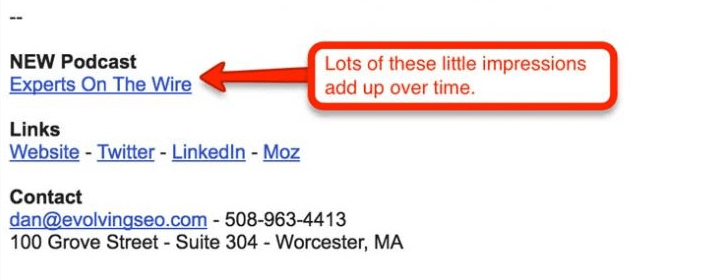
15. Identify Key Hashtags for Your Niche
Using hashtags in your social media content is a great way to expose your content to potential listeners who enjoy that subject. It’s smart to use a handful of hashtags in every post, no matter the platform.
Take some time to research some hashtags that make sense for your show. Some hashtags are obvious, but others aren’t intuitive. For instance, if you have a podcast about women leaders, you might use #entrepreneur and #business, but you should also include niche-specific and culturally impactful hashtags like #girlboss, #bosslady, and #girlpower.
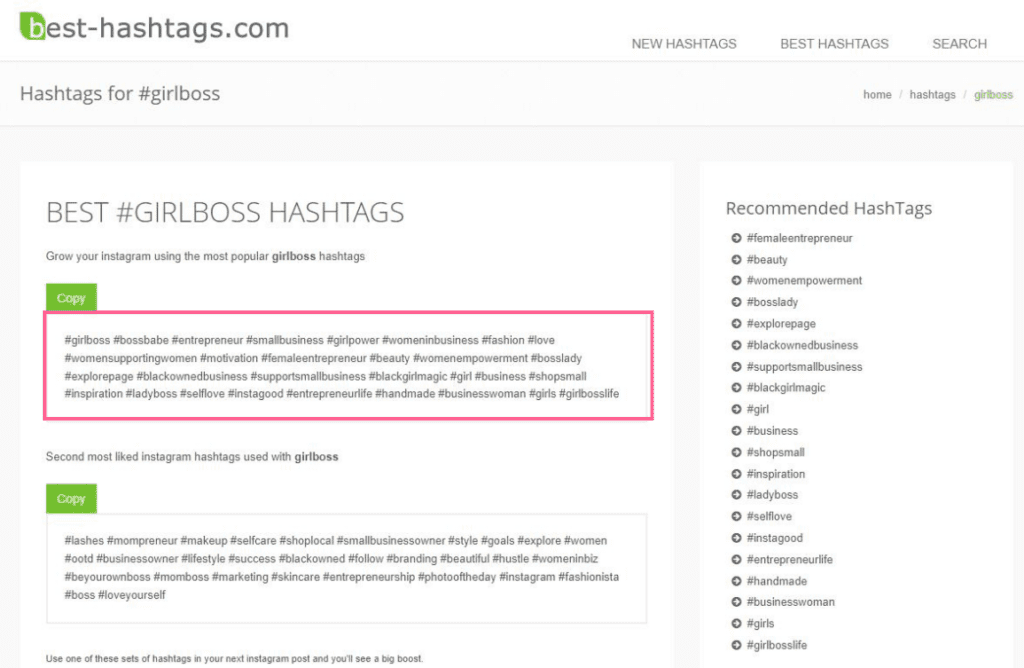
Here are some useful resources to find hashtags related to your niche:
16. Create a Short Slide Deck for Your Show
A slide deck is a simple document that you send to other podcast hosts, potential guests, advertisers, and anyone you hope to work with. It’s similar to a media kit, but shorter and quicker to read. (It’s sometimes called a “one-sheet” or “one-pager,” but it doesn’t have to be one page.)
A slide deck does not replace a pitch. When you speak with collaborators or cross-promoters, find sponsors, or request to be a guest, you’ll still need to put a proper pitch together.
When you create a slide deck, try not to overthink it. The goal is to convey a lot of information in a concise manner. Don’t pack it full of what you think the reader wants to see, just be yourself.
Here’s what your slide deck should include:
- Your headshot
- Your name
- Name of the podcast
- Podcast website
- Topics you cover
- What you’re an expert on
- Who is your audience?
- Social media and email contacts
- Audience stats
- Production schedule
- Scheduling link (Calendly, Savvycal, etc.)
Want to see an example of a podcast slide deck? Check out our slide deck for one of our podcasters, 3 Clips. (Click here to see the full slide deck.)
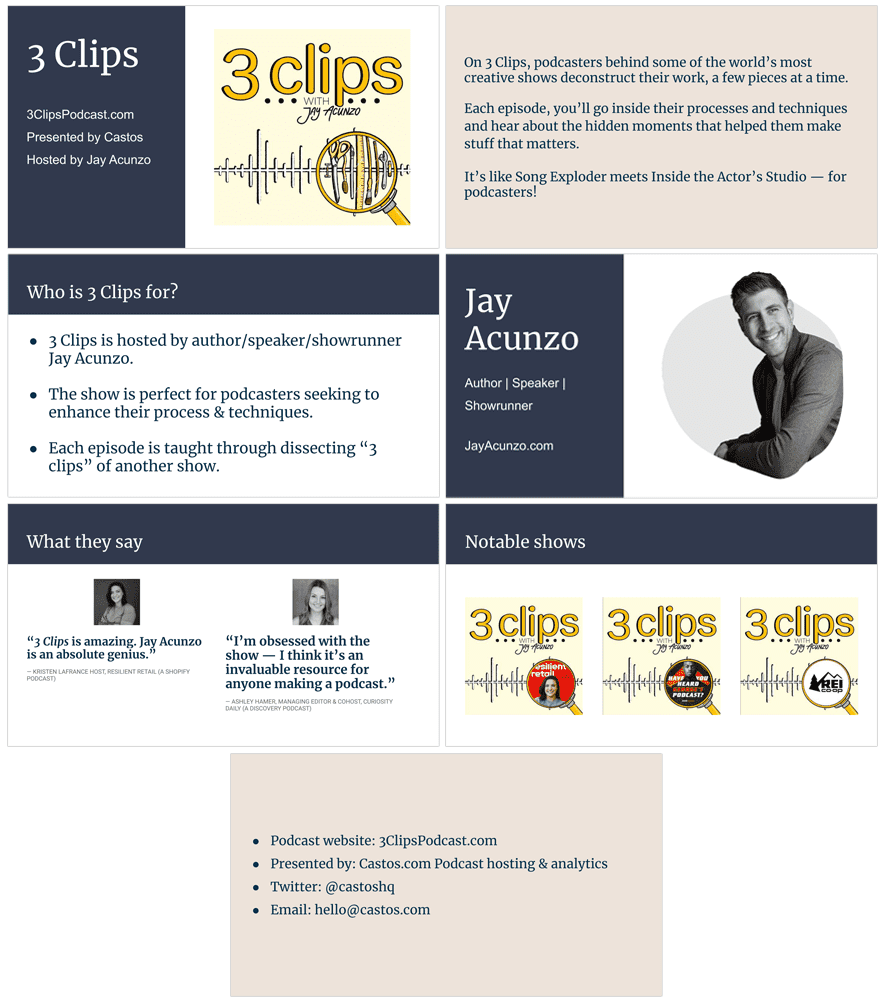
17. Notify Your Personal Network
Your friends, family, and colleagues are excellent sources of new listeners. They may not love your content, but they will listen because they care about you. This is a great way to start sending positive signals to the podcast listening apps so they boost your ranking.
When you notify your personal network, ask them very clearly to rate and review your podcast. Don’t be coy here. Explain the significance of this system and this system and how important a 5-star rating and a good review can mean for your show. Beg them if you have to. Offer to help them move or something. Whatever it takes.
18. Post Something on Your Blog
Create a blog post on your website announcing the launch of your show. Include lots of information about your topic, your personal experience, and what your audience can’t expect from your show. Craft this piece well because it’s a great resource to share on social media.
19. Notify Your Email List
If you have an email list already, you’ll want to let them know that you’ve started a podcast. Don’t be afraid to send a few emails as you get close to launching your show. Then send the following email on the day your episodes are live.
Hi NAME,
We’ve got some exciting news today!
We just went live with our newest podcast, <<podcast name here>>.
<<insert cover image here, linking it to your podcast website>>
This show is all about <<what the main value prop of your show is>>.
In the first few episodes we cover:
- <<topic 1 – with Guest_1_Name>>
- <<topic 2 – with Guest_2_Name>>
- <<topic 3 – with Guest_2_Name>>
We also have a bunch of other great episodes already planned out with guests that you and I both know well from our industry.
Check out the podcast here:
<<button linking to your podcast website>>
If you’re enjoying the show we just ask that you share it with someone who you think would enjoy it as well.
Cheers,
<<your name>>
Grow Your Audience with Castos
Castos gives you all the tools and expert guidance you’ll need to create an incredible podcast that will make a lasting impression for your brand.
20. Add Value to Online Communities
There are millions of conversations happening on Facebook, Quora, Reddit, and Twitter likely around the topic of your podcast. One of your episodes could add value to the discussion and introduce the show to new listeners.
Search each platform for threads and forums related to your show. Once you find a few groups with enough engagement, start adding your value.
But be mindful. This strategy takes tact. First focus on solely being part of the conversation without promoting your show. Actually being part of the community will be beneficial when a the right post to promote yourself does come along. If you come off as too promotional, your podcast marketing will seem like, well, marketing.
21. Optimize Your Website for Search
A podcast website is important. From SEO benefits to being a platform you fully control, all shows should have their own site. But what good is a website if you’re not regularly updating it with your freshest content?
Each time you upload a new episode and it’s distributed to every listening app, create a new post on your website too. The post should have an embedded player, transcriptions, and show notes to make the biggest impact.
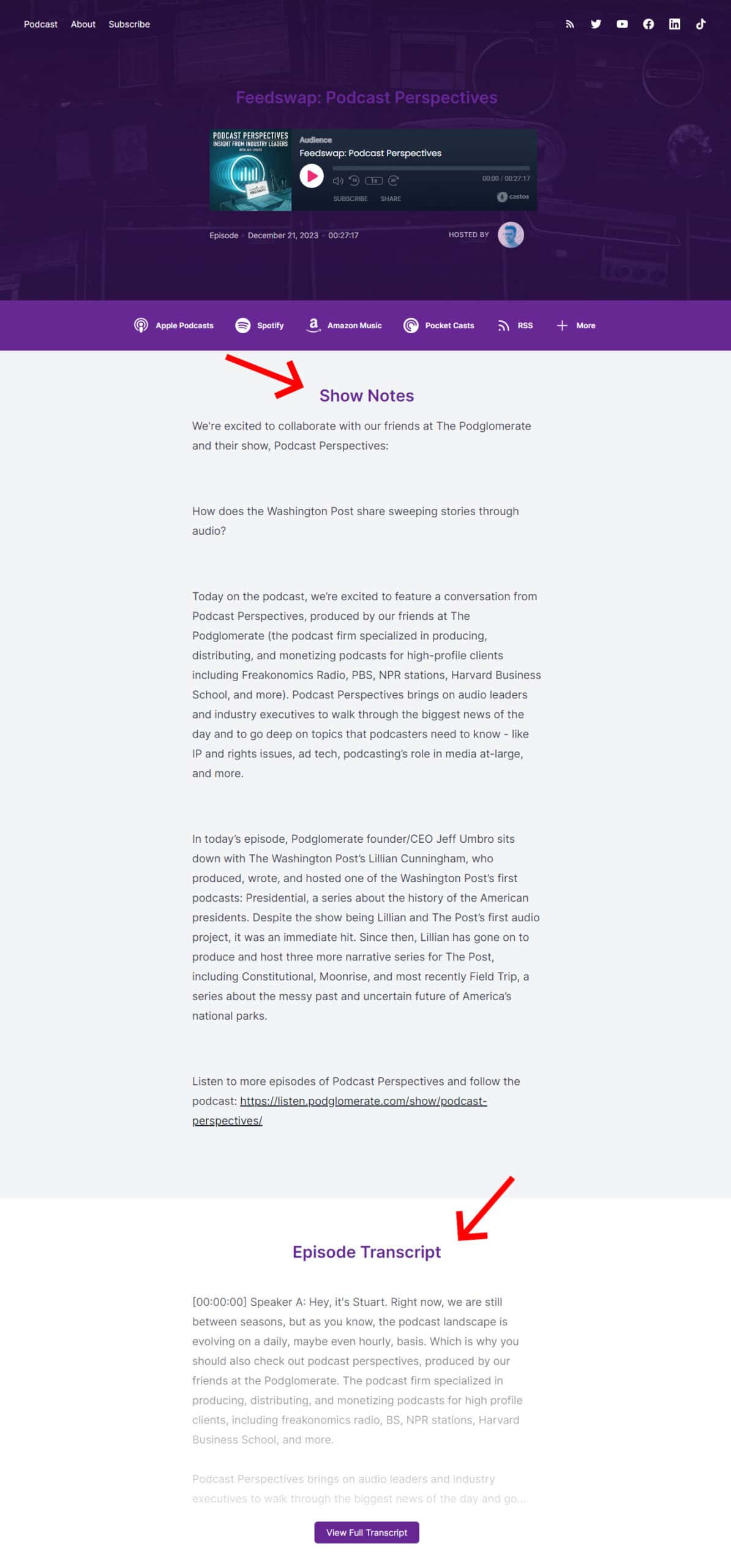
When you create a page, make sure it’s optimized around a keyword people search for to find that kind of content. Put that keyword in the following places:
- The page’s H1 title
- Some of the page’s subheadings, including H2, H3, H4, etc.
- The ALT attribute of any images
- At the beginning and end of the content
- In the page’s meta description
- In the page’s <TITLE> tag, if different than the page’s H1
- Scattered throughout the content regularly, but don’t sacrifice readability
Recently, Google started crawling audio material and including podcasts in search results. To capitalize on this update, try targeting episode titles to a few keyword phrases your intended audience often searches for. Include those same keywords on that episode’s post for double SEO benefits.
22. Connect with Influencers
Influencer marketing is the practice of using influential people to expose your podcast to new audiences. Essentially, you just find someone who has a following that overlaps with your target audience, reach out to them, and build a mutually beneficial partnership to promote your podcast.
Keep in mind that this podcast marketing technique requires some reciprocity. If you want to work with an influencer, you have to give something back as well. You may have to give them a shout out on your show, free products, or some kind of monetary compensation. Every influencer has their own goals, so be open to unique arrangements.
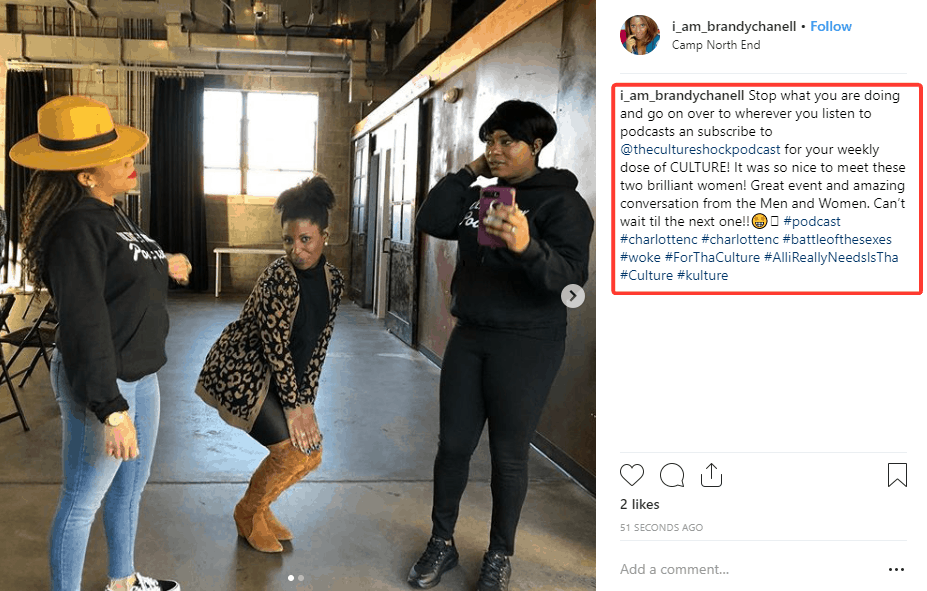
Podcast Marketing Wrap-Up
That covers the basics of podcast marketing. Like we said earlier, the best marketing is whatever works for your show and your audience. Don’t be afraid to try new things and network with the new people in order to identify the techniques that help your show grow.



